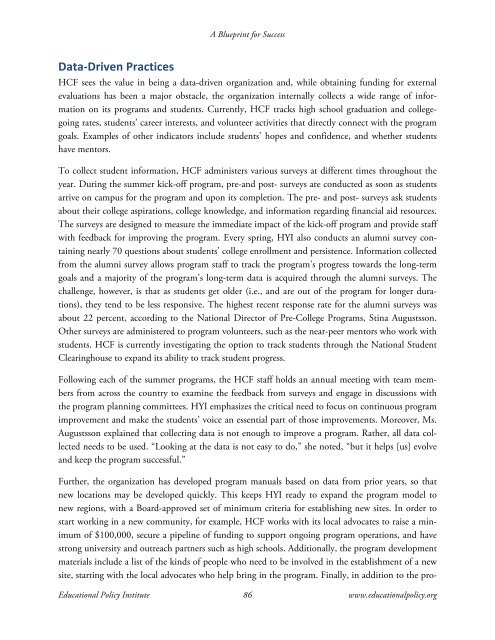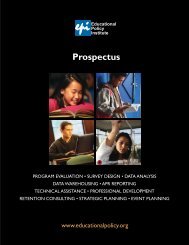A BluePrint for Success: Case Studies of Successful - Educational ...
A BluePrint for Success: Case Studies of Successful - Educational ...
A BluePrint for Success: Case Studies of Successful - Educational ...
Create successful ePaper yourself
Turn your PDF publications into a flip-book with our unique Google optimized e-Paper software.
Data-‐Driven Practices<br />
A Blueprint <strong>for</strong> <strong>Success</strong><br />
HCF sees the value in being a data-driven organization and, while obtaining funding <strong>for</strong> external<br />
evaluations has been a major obstacle, the organization internally collects a wide range <strong>of</strong> in<strong>for</strong>mation<br />
on its programs and students. Currently, HCF tracks high school graduation and collegegoing<br />
rates, students’ career interests, and volunteer activities that directly connect with the program<br />
goals. Examples <strong>of</strong> other indicators include students’ hopes and confidence, and whether students<br />
have mentors.<br />
To collect student in<strong>for</strong>mation, HCF administers various surveys at different times throughout the<br />
year. During the summer kick-<strong>of</strong>f program, pre-and post- surveys are conducted as soon as students<br />
arrive on campus <strong>for</strong> the program and upon its completion. The pre- and post- surveys ask students<br />
about their college aspirations, college knowledge, and in<strong>for</strong>mation regarding financial aid resources.<br />
The surveys are designed to measure the immediate impact <strong>of</strong> the kick-<strong>of</strong>f program and provide staff<br />
with feedback <strong>for</strong> improving the program. Every spring, HYI also conducts an alumni survey containing<br />
nearly 70 questions about students’ college enrollment and persistence. In<strong>for</strong>mation collected<br />
from the alumni survey allows program staff to track the program’s progress towards the long-term<br />
goals and a majority <strong>of</strong> the program’s long-term data is acquired through the alumni surveys. The<br />
challenge, however, is that as students get older (i.e., and are out <strong>of</strong> the program <strong>for</strong> longer durations),<br />
they tend to be less responsive. The highest recent response rate <strong>for</strong> the alumni surveys was<br />
about 22 percent, according to the National Director <strong>of</strong> Pre-College Programs, Stina Augustsson.<br />
Other surveys are administered to program volunteers, such as the near-peer mentors who work with<br />
students. HCF is currently investigating the option to track students through the National Student<br />
Clearinghouse to expand its ability to track student progress.<br />
Following each <strong>of</strong> the summer programs, the HCF staff holds an annual meeting with team members<br />
from across the country to examine the feedback from surveys and engage in discussions with<br />
the program planning committees. HYI emphasizes the critical need to focus on continuous program<br />
improvement and make the students’ voice an essential part <strong>of</strong> those improvements. Moreover, Ms.<br />
Augustsson explained that collecting data is not enough to improve a program. Rather, all data collected<br />
needs to be used. “Looking at the data is not easy to do,” she noted, “but it helps [us] evolve<br />
and keep the program successful.”<br />
Further, the organization has developed program manuals based on data from prior years, so that<br />
new locations may be developed quickly. This keeps HYI ready to expand the program model to<br />
new regions, with a Board-approved set <strong>of</strong> minimum criteria <strong>for</strong> establishing new sites. In order to<br />
start working in a new community, <strong>for</strong> example, HCF works with its local advocates to raise a minimum<br />
<strong>of</strong> $100,000, secure a pipeline <strong>of</strong> funding to support ongoing program operations, and have<br />
strong university and outreach partners such as high schools. Additionally, the program development<br />
materials include a list <strong>of</strong> the kinds <strong>of</strong> people who need to be involved in the establishment <strong>of</strong> a new<br />
site, starting with the local advocates who help bring in the program. Finally, in addition to the pro-<br />
<strong>Educational</strong> Policy Institute 86 www.educationalpolicy.org




